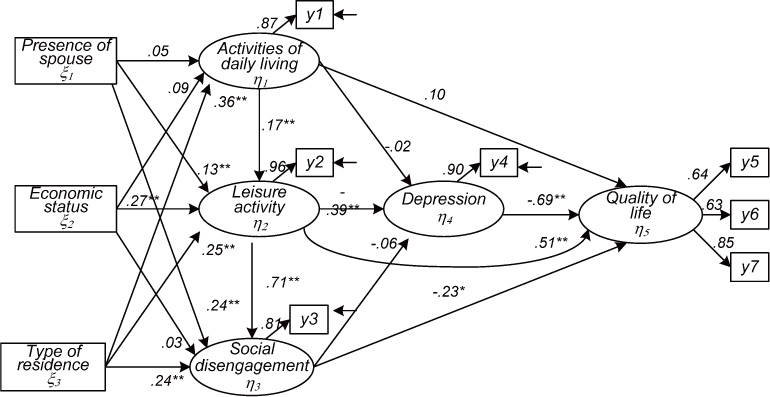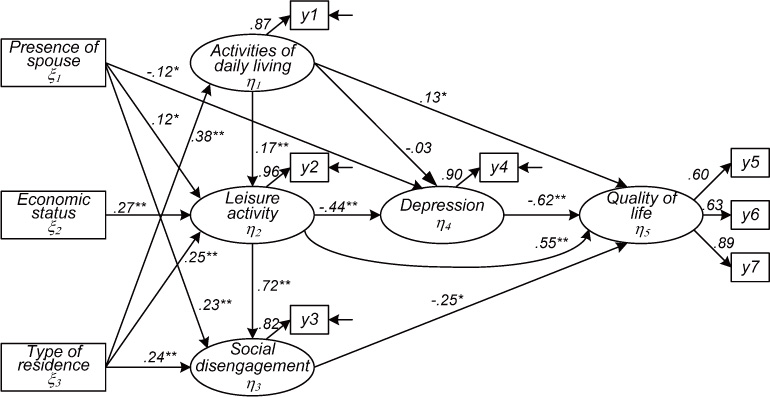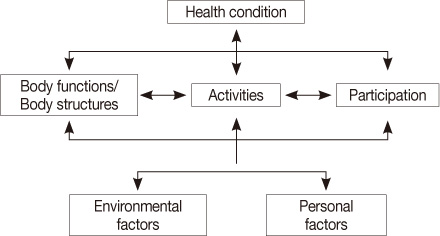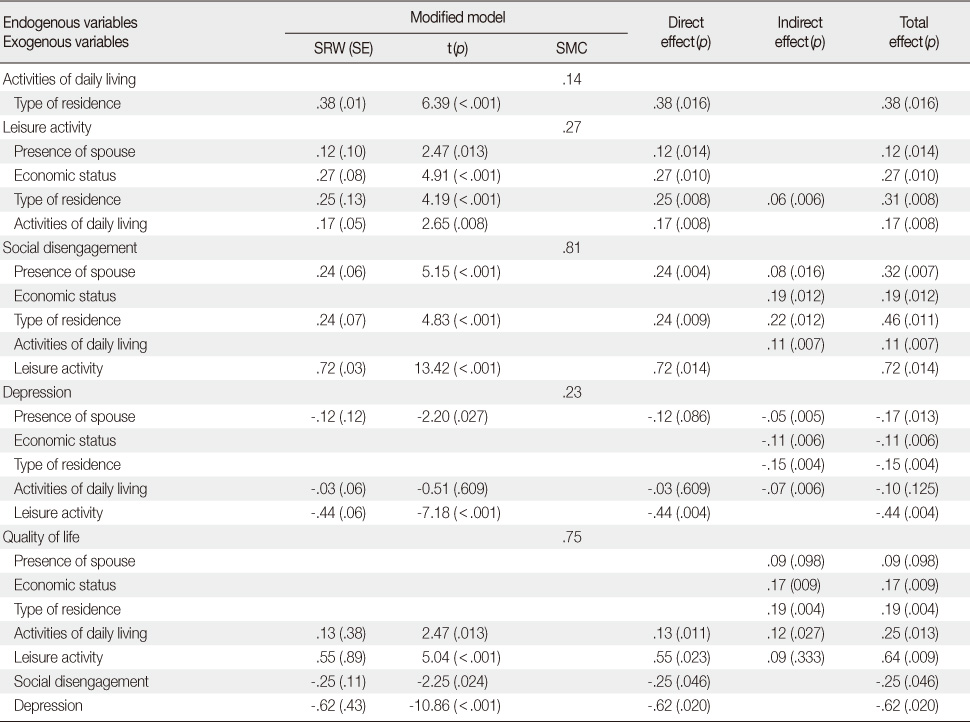Articles
- Page Path
- HOME > J Korean Acad Nurs > Volume 41(4); 2011 > Article
-
Original Article
- Prediction Model of Quality of Life in Elderly Based on ICF Model
- Heeyoung So, Hyunli Kim, Kyungok Ju
-
Journal of Korean Academy of Nursing 2011;41(4):481-490.
DOI: https://doi.org/10.4040/jkan.2011.41.4.481
Published online: August 31, 2011
1Professor, Chungnam National University College of Nursing, Daejeon, Korea.
2Visiting Professor, Graduate School of Education, Chungnam National University, Daejeon, Korea.
- Address reprint requests to: So, Heeyoung. College of Nursing, Chungnam National University, 1-6 Munwha-dong, Jung-gu, Daejeon 301-747, Korea. Tel: +82-42-580-8325, Fax: +82-42-580-8309, hysoh@cnu.ac.kr
© 2011 Korean Society of Nursing Science
Abstract
-
Purpose
- The purpose of this study was to identify from the International Classification of Functioning model, factors influencing quality of life in elderly persons and to describe the concrete pathway of influence and the power of each variable.
-
Methods
- The sample included 334 elders who lived in 5 districts of D Metropolitan City. A structured questionnaire was used and the collected data were analyzed for fitness, using the AMOS 18.0 program.
-
Results
- This model was concise and extensive in predicting the quality of life of elders. The research verified the factors influencing quality of life for elders as direct factors such as activity of daily living (ADL) (β=.13, t=2.47), leisure activity (β=.55, t=5.04), social disengagement (β=-.25, t=-2.25), and depression (β=-.62, t=-10.86). Indirect factors including economic status (γ=.17, p=.009), type of residence (γ=.19, p=.004), ADL (γ=.12, p=.027) were important factors in predicting quality of life for elders. These variables explained 75.6% of variance in the prediction model.
-
Conclusion
- The findings indicate a need for the nursing scientific community to develop intervention programs considering these variables to improve the quality of life for elders.
- 1. Bae JH, Lee HK, Kim HS, Oh HJ. A study on activities of daily living, mental status and life satisfaction of the elderly living in home and in institutions. Journal of Korean Society of Physical Therapy. 2008;20(2):33–41.
- 2. Bae NR, Park CS. A study on the ecological factors affecting the quality of life among the elderly people. Journal of the Korean Gerontological Society. 2009;29:761–779.
- 3. Bassuk SS, Glass TA, Berkman LF. Social disengagement and incident cognitive decline in community-dwelling elderly persons. Annals of Internal Medicine. 1999;131:165–173. url: annals.org/content/131/3/165.ArticlePubMed
- 4. Breeze E, Jones DA, Wilkinson P, Latif AM, Bulpitt CJ, Fletcher AE. Association of quality of life in old age in Britain with socioeconomic position: Baseline data from a randomized controlled trial. Journal of Epidemiology and Community Health. 2004;58:667–673. doi: 10.1136/jech.2003.014035.PubMedPMC
- 5. Chang KY, Kang JM. The study of activities of daily living performance and quality of life for elderly residents in the Daejeon city. Journal of Korean Academy of Occupational Therapy. 2005;13(1):45–56.
- 6. Cumming E, Henry WE. Growing old: The process of disengagement. 1961;New York, Basic Books.
- 7. Dragomirecka E, Bartonova J, Eisemann M, Kalfoss M, Kilian R, Martiny K, et al. Demographic and psychosocial correlates of quality of life in the elderly from a cross-cultural perspective. Clinical Psychology and Psychotherapy. 2008;15:193–204. doi: 10.1002/cpp.571.ArticlePubMed
- 8. Gabriel Z, Bowling A. Quality of life from the perspectives of older people. Ageing & Society. 2004;24:675–691. doi: 10.1017/S0144686X03001582.Article
- 9. Jöreskog KG, Sörbom D. LISREL 7: A guide to the program and applications. 1989;Chicago, SPSS Publications.
- 10. Jung HY, Park BK, Shin HS, Kang YK, Pyun SB, Paik NJ, et al. Development of the Korean version of modified Barthel Index (K-MBI): Multi-center study for subjects with stroke. Journal of Korean Academy of Rehabilitation Medicine. 2007;31:283–297.
- 11. Kim JS. A study of quality of life of the elderly in rural areas. 2009;Gwangju, Chosun University. Unpublished master's thesis.
- 12. Kim MY. Factors that influence satisfaction level towards the life by the leisure activity of users of the senior citizens' leisure welfare facilities. 2009;Daegu, Daegu Haany University. Unpublished doctoral dissertation.
- 13. Kodzi IA, Obeng GS, Emina JC, Ezeh A. Religious involvement, social engagement, and subjective health status of older residents of informal neighborhoods of Nairobi. Journal of Urban Health. 2011;88:S370–S380. doi: 10.1007/s11524-010-9482-0.PubMed
- 14. Lee DH. The effects of quality of life in the elderly's health condition. Journal of the Korean Gerontological Society. 2010;30:93–108. doi: 210.101.116.28/47201167.
- 15. Lee MG. Inquiry into the life satisfaction of the Korean elderly through leisure activities. 2007;Chuncheon, Kangwon National University. Unpublished doctoral dissertation.
- 16. Lee YR, Park MS. An ecological study on the leisure and quality of life for those who reside in free institutionalized elderly homes: Applying a structural equation model. Journal of the Korean Home Economics Association. 2006;44(11):117–131.
- 17. Levasseur M, Tribble DS, Desrosiers J. Meaning of quality of life for older adults: Importance of human functioning components. Archives of Gerontology and Geriatrics. 2009;49:e91–e100. doi: 10.1016/J.archger.2008.08.013.ArticlePubMed
- 18. Lin PL, Yen M, Fetzer SJ. Quality of life in elders living alone in Taiwan. Journal of Clinical Nursing. 2008;17(12):1610–1617. doi: 10.1016/J.archger.2008.08.013.ArticlePubMed
- 19. Min SK, Lee CI, Kim KI, Suh SY, Kim DK. Development of Korean version of World Health Organization Quality of Life Scale abbreviated version (WHOQOL-BREF). Journal of Korean Neuropsychiatric Association. 2000;39:571–579.
- 20. 2008 Survey of the elderly: National elderly living conditions and welfare needs. Ministry of Health and Welfare. 2009;Retrieved August 16, 2010. from www.mw.go.kr.
- 21. Nóbrega TC, Jaluul O, Machado AN, Paschoal SM, Filho WJ. Quality of life and multimorbidity of elderly outpatients. Clinics. 2009;64:45–50. doi: 10.1590/S1807-59322209000100009.ArticlePubMedPMC
- 22. Moon MJ. Analysis on the structural model of life satisfaction for elderly home residents. Journal of Korean Gerontological Nursing. 2004;6:202–215.
- 23. Paskulin L, Vianna L, Molzahn AE. Factors associated with quality of life of Brazilian older adults. International Nursing Review. 2009;56:109–115. doi: 10.1111/J.1466-7657.2008.00671.ArticlePubMed
- 24. Pfeiffer E. A short portable mental status questionnaire for the assessment of organic brain deficit in elderly patients. Journal of the American Geriatrics Society. 1974;23:433–441.Article
- 25. Sheikh JI, Yesavage JA. Geriatric Depression Scale (GDS): Recent evidence and development of shorter version. Clinical Gerontologist. 1986;5(1-2):165–173. doi: 10.1300/J018v05n0109.Article
- 26. Skevington LD, Lofty M, O'Connell KA. The World Health Organization's WHOQOL-BREF quality of life assessment: Psychometric properties and results of the international field trial a report from the WHOQOL Group. Quality of Life Research. 2004;13:299–310. doi: 10.1023/B:QURE.0000018486.91360.00.ArticlePubMed
- 27. Sohn S. A comparative study on the life quality of the elderly and it's affecting factors between rural and urban areas. Journal of the Korean Gerontological Society. 2006;26(3):601–615. doi: 210.101.116.28./47200849.
- 28. Korean statistical information service. Statistics Korea. 2007;Retrieved August 16, 2010. from http://kostat.go.kr.
- 29. WHOQOL Group. The World Health Organization Quality of Life Assessment (WHOQOL): Position paper from the World Health Organization. Social Science and Medicine. 1995;41(10):1403–1409. doi: 10.1016/0277-936(95)00110-K.ArticlePubMed
- 30. The international classification of functioning, disability and health-ICF. World Health Organization. 2001;Retrieved August 16, 2010. from http://www.who.int/classifications/icf/en/.
REFERENCES


Figure & Data
REFERENCES
Citations

- Analysis of Research Trends on Older Adults with Hearing Loss in Korea: Using the ICF Core Set
Soo Jin Cho, Mi Sook Lee, Yu Ri Lee
Audiology and Speech Research.2024; 20(1): 6. CrossRef - A structural equation modeling approach to understanding physical function of terminal cancer patients
Han-Gyo Choi, Hye-Ah Yeom, Myung Ah Lee, Jeong-Ran Ra
Supportive Care in Cancer.2022; 30(2): 1149. CrossRef - Structural equation model of the relationship between functional ability, mental health, and quality of life in older adults living alone
YuMi Yi, Yeon-Hwan Park, Gianni Virgili
PLOS ONE.2022; 17(8): e0269003. CrossRef - Effects of occupational balance on subjective health, quality of life, and health-related variables in community-dwelling older adults: A structural equation modeling approach
Sangmi Park, Hae Jong Lee, Byoung-Jin Jeon, Eun-Young Yoo, Jong-Bae Kim, Ji-Hyuk Park, Yee Cheng Kueh
PLOS ONE.2021; 16(2): e0246887. CrossRef - Predictive Model for Quality of Life of the Older Men Living Alone
Su Jin Kim, Gyeong-Suk Jeon
Journal of Korean Academy of Nursing.2020; 50(6): 799. CrossRef - A study on the Relationship among Depression, Walking and Quality of Life for the Elderly -Focusing on the Moderation Effects of Walking-
Hee-Seung Song
Journal of Digital Convergence.2016; 14(8): 515. CrossRef - Effects of Life Satisfaction of the Elderly Participating in the Senior Employment Project
Yong-Shik Yoo
The Journal of the Korea Contents Association.2016; 16(1): 129. CrossRef - Most common problems across health conditions as described by the International Classification of Functioning, Disability, and Health
Pavel Ptyushkin, Alarcos Cieza, Gerold Stucki
International Journal of Rehabilitation Research.2015; 38(3): 253. CrossRef - Influencing of Quality of Life for Elderly Employment Program Participants - Social Support(Social Activities, Family/Social Relationship), Emotional Problems
Cin-Jae Chang, Ja-Young Cho
The Journal of the Korea Contents Association.2014; 14(11): 225. CrossRef - A Comparative Study on Influencing Factors of Health Related Quality of Life of the Elderly in Senior Center by Region : Focus on Urban and Rural Areas
Soon-Ok Yang, Hae-Ryun Cho, Seung-Hee Lee
The Journal of Digital Policy and Management.2014; 12(1): 501. CrossRef - Gender Difference in Influencing Factors on Health related Quality of Life among the Elderly in Community
Seung-Hee Lee
The Journal of Digital Policy and Management.2013; 11(12): 523. CrossRef - A Prediction Model for Depression in Patients with Parkinson's Disease
Eun Sook Bae, Sang Myung Chun, Jae Woo Kim, Chang Wan Kang
Korean Journal of Health Education and Promotion.2013; 30(5): 139. CrossRef - Design and Technologies for Understanding Older Adults Social Interactions in Retirement Communities
Claudia B. Rebola, Gbolabo Ogunmakin, Patricio A. Vela
International Journal of Social Robotics.2013; 5(4): 575. CrossRef - Health-Related Factors Influencing the Quality of Life of Rural Elderly Subjects - Activities of Daily Living, Cognitive Functions, Prevalence of Chronic Diseases and Nutritional Assessment
Mee Sook Lee
Korean Journal of Community Nutrition.2012; 17(6): 772. CrossRef



Figure 1
Figure 2
Figure 3
Model Fitness Index for Hypothetical and Modified Model (N=334)
GFI=Goodness of fit index; SRMR=Standardized root mean square residual; NNFI=Normed fit index; CFI=Comparative fit index; PNFI=Parsimonious normed fit index; RMSEA=Root mean square residual.
Direct Effect, Indirect Effect, and Total Effect in Modified Path Model (N=334)
SRW=Standardized regression weight; SMC=Squared multiple correlation.
GFI=Goodness of fit index; SRMR=Standardized root mean square residual; NNFI=Normed fit index; CFI=Comparative fit index; PNFI=Parsimonious normed fit index; RMSEA=Root mean square residual.
SRW=Standardized regression weight; SMC=Squared multiple correlation.
 KSNS
KSNS
 E-SUBMISSION
E-SUBMISSION



 Cite
Cite

